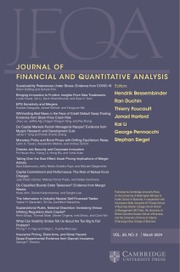No CrossRef data available.
Article contents
Debt Maturity and Investor Heterogeneity
Published online by Cambridge University Press: 08 July 2025
Abstract
This paper studies how investor heterogeneity impacts equilibrium debt maturity. The optimal issuance strategy combines long- and short-term debts. A long-term debt contains default risk but hedges against intermediate downturns. A short-term debt provides repayment commitment but requires being rolled over and becomes risky during downturns. Issuing multiple debt maturities spreads the cost of these risky claims to investors most willing to hold risk at different points in time. The model predicts that debt maturity is more dispersed with lower financing costs and more investment opportunities when debt ownership is spread among many different types of investors.
Information
- Type
- Research Article
- Information
- Journal of Financial and Quantitative Analysis , Volume 60 , Issue 5 , August 2025 , pp. 2431 - 2468
- Copyright
- © The Author(s), 2025. Published by Cambridge University Press on behalf of the Michael G. Foster School of Business, University of Washington
Footnotes
This paper was previously circulated under the titles “A Model of Endogenous Debt Maturity with Heterogeneous Agents” and “A Collateral Theory of Endogenous Debt Maturity.” We are especially thankful to Ana Fostel for numerous discussions. We thank Ye Li (discussant), Dan Cao, Piero Gottardi, Sebnem Kalemli-Ozcan, Yulyian Mitkhov, Greg Phelan, Alex Vardoulakis, Francesca Zucchi, and participants from numerous conferences for useful suggestions. The views expressed in this paper are those of the authors and do not necessarily represent those of the Federal Reserve Board of Governors or anyone in the Federal Reserve System, U.S. Department of Treasury, or Office of the Comptroller of the Currency. All errors are our own.

